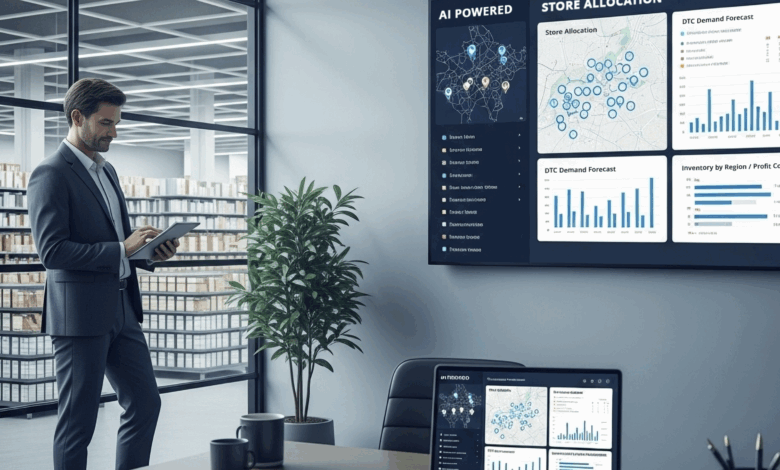
It’s no secret that artificial intelligence has changed the world, but the full power of what this technology can do has yet to be discovered—especially in the retail space. Many retail tech solutions are serving the industry with AI-powered demand forecasting and personalization capabilities, but true impact and ROI comes from embedding AI throughout the merchandising cycle, across channels.
According to NVIDIA’s report on the State of AI in Retail and CPG in 2025, 42% of retail firms are actively using AI in their operations, while 47% are still in the assessment phase. However, only a little over half of those using the technology are using it for more than six use cases stretching across their operations.
For retailers that aren’t using AI across their workflow, forecasting tends to be the one place where they are using it. A recent 7thonline survey of 100+ retail executives revealed that 33% of leaders are currently using AI to analyze data and forecast demand. Of course, forecasting is a critical piece of the retail puzzle, especially as demand fluctuates and expectations rise, but it’s not the only piece. AI should also be embedded in inventory management, supply chain management, merchandising and planning, in-season open-to-buy, sentiment analysis and more.

Why AI Is Needed in Every Part of Retail
While AI has many benefits, the true value of AI in retail comes from its ability to boost profitability and preserve margins through proactive, data-driven decisions. NVIDIA reported four out of five retailers using AI claim it has boosted their annual revenue, with 25% stating revenue increased by more than 20%. Success isn’t achieved by simply adding AI to a tool and hoping for results, it’s achieved by embedding it into every stage of the retail workflow.
Fully embedding AI into every step of the retail workflow enables cross-functional collaboration, unified planning and smarter execution; comprehensive, real-time analysis of demand is a powerful tool for retailers to drive ROI through connected merchandising decisions across channels. When live data is consolidated and easily accessible on a single platform, it ensures that every team member has the most current and accurate insights—maximizing inventory productivity with smart decisions spanning assortment planning, allocation and inventory management. Realize the full potential of artificial intelligence by making it an integral part of your decision-making throughout the merchandising process.

How AI Should Be Embedded in All Retail Processes
Retailers using AI for forecasting have seen impactful benefits, but without end-to-end integration, its full potential remains untapped; forecasting is only the first step to AI adoption in retail. 7thonline’s latest survey revealed that while only 16% of those utilizing AI are using it for demand forecasting, 34% of retail leaders expect AI to play a major role in sustaining or growing profits within the next two years.
With the rapid advancements in retail tech and the plethora of AI types (generative AI, conversational AI, predictive AI, prescriptive AI, agentic AI, etc.) surfacing in the retail world, retailers are able to adopt AI for distinctive use cases. Generative AI is enabling retailers to churn out personalized marketing campaigns to engage shoppers. Conversational AI is strengthening customer service online. Predictive AI is all the rage for retailers focused on demand forecasting, predicting how their target audience will react to products, down to style, color, size, across channels for profitable assortment mixes and allocation. Prescriptive AI takes predictive a step further and provides recommendations for the best possible outcome: increasing sales, improving order fill rate, etc. Retailers that understand when to use each can turn data into strategic advantage including boosting efficiency, accuracy and performance across their operations.
Here are some ways AI should be embedded into different steps of the retail process:
- Supply Chain Management – AI helps retailers navigate the complexities of global trade in response to tariffs, sanctions and other disruptions affecting various parts of the supply chain to better align production decisions and shopper demand Utilizing AI-driven insights, such as “what if” scenarios, retailers are able to determine what might happen if they need to switch suppliers or where they get their products from.
- Inventory Management – Pre and in-season inventory management is one of the most common AI use cases in retail, according to NVIDIA; retailers can stay ahead of the game with decisions that maximize inventory productivity and enhance customer satisfaction. Using AI, they can create detailed item-level plans across channels, make dynamic open-to-buy decisions and allocate based on localized demand for each store. Utilizing AI and real-time sales data, retailers are able to determine each item’s propensity to sell at different locations and predict when products will sell out during the season—enabling proactive reorder decisions to maintain the right assortment mix down to style, color, size. Deep demand insights empower data-driven decisions based on the latest selling trends, such as when to replenish stock, reorder best sellers or develop a promotional plan for slow-moving items.
- Demand Planning – AI improves demand forecasting accuracy and identifies risks and opportunities with robust visibility into what resonates with consumers, reducing inventory risk and driving strategic growth. NVIDIA revealed analytics and insights into areas like sentiment are a common use case for AI in retail—helping retailers understand consumer behavior based on all customer affinities: product, time, location and media consumption. AI can crawl for customer reviews and social media posts to uncover product sentiment and marketing contribution margins, enabling retailers to adjust their merchandising and promotional strategies. By analyzing the performance of past products, AI can also make predictions about how well new styles might sell based on the demand of previous products with similar attributes for smart expansions into new markets and product categories.
Making the Most of AI in Retail
Many retailers who have dipped their proverbial toe into the water of AI have only scratched the surface of what it can do; until retailers embed AI into every step of their operational workflow, they won’t be able to reap the full benefits. With AI embedded into every aspect of their multi-channel processes, that’s when their business will truly soar.




